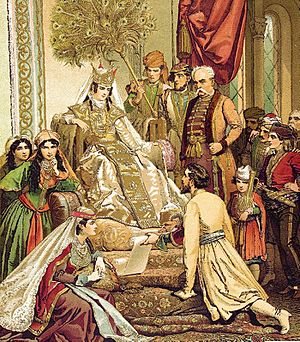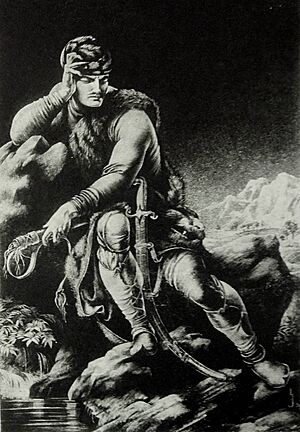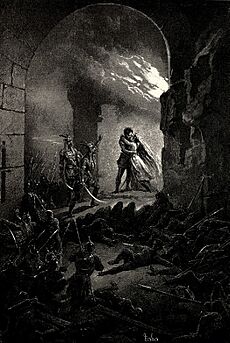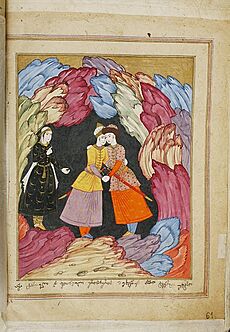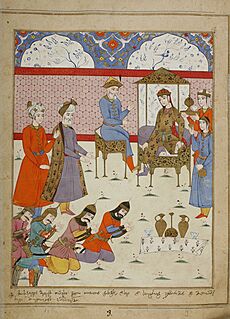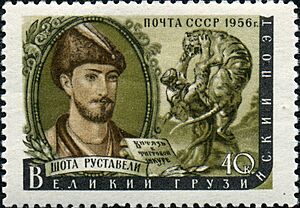The Knight in the Panther's Skin facts for kids
Quick facts for kids ვეფხისტყაოსანი |
|
|---|---|
| The Knight in the Panther's Skin | |
|
17th-century manuscript of Vepkhistkaosani
|
|
| Author(s) | Shota Rustaveli |
| Dedicated to | King Tamar of Georgia |
| Language | Middle Georgian |
| Date | c. 1180–1205/07 |
| First printed edition | by King Vakhtang VI in 1712 |
| Genre | Epic poetry, national epic, chivalric romance |
| Verse form | Rustavelian quatrain |
| Length | 6,648 lines |
| Subject | Love, friendship, heroism, loyalty |
| Period covered | Reign of King Tamar of Georgia Georgian Golden Age |
The Knight in the Panther's Skin (Georgian: ვეფხისტყაოსანი, romanized: vepkhist'q'aosani), also known as Vepkhistkaosani, is a famous Georgian medieval poem. It was written around the 12th or 13th century by Shota Rustaveli, who is Georgia's national poet. This epic poem is a key work from the Georgian Golden Age, a time when Georgia was very strong and successful.
The poem has over 1600 stanzas, each with four lines, called Rustavelian Quatrains. It is seen as a masterpiece of Georgian literature. For many years, up until the early 1900s, a copy of this poem was a special gift given to every bride as part of her dowry.
Even though the story happens in made-up places like "India" and "Arabia", these faraway lands are a colorful way to talk about the rule of Queen Tamar of Georgia and the greatness of the Kingdom of Georgia during its Golden Age. The poem tells the story of two brave friends, Avtandil and Tariel. They go on a journey to find Nestan-Darejan, the person Tariel loves. Nestan-Darejan represents Queen Tamar in the story.
These heroes are perfect examples of loyalty, kindness, honesty, and strong friendship. The poem is a deep and complex work that shows the best of medieval Georgian thought and art. It is called an "epic", a "chivalric romance", and an "epic poem of lyric poetry." Even today, it shares the "Georgian vision of the world."
The Story Behind the Poem
When Was The Knight in the Panther's Skin Written?
The poem was created during the Georgian Golden Age, a time of great success for the Kingdom of Georgia. This was during the rule of Queen Tamar. Her father, King George III of Georgia, made her queen.
Queen Tamar was admired by poets for her beauty, intelligence, and diplomatic skills. She made the Georgian kingdom bigger than ever before. She also stopped invasions and protected many Muslim and Christian lands.
What Was Georgia Like During the Golden Age?
Under Queen Tamar, Georgia's economy grew strong. Georgian traders traveled to places like Ayyubid Egypt, the Kievan Rus, and the Byzantine Empire. Science and art also thrived. Many large monasteries and churches were built in Georgia. Non-religious literature became as important as religious texts.
Shota Rustaveli wrote his poem during this time of "remarkable growth." Rustaveli was born in a village called Rustavi. He was close to Queen Tamar and might have even been her treasurer. He probably joined her on many military trips.
The stories in his poem happen in faraway places. However, they are a hidden way of talking about Georgia at that time. For example, he mentions wine culture and a female ruler who took over from her father.
What Did Rustaveli Say About His Poem?
In the poem's beginning, called the prologue, Rustaveli says he wrote it to praise Queen Tamar.
|
თამარს ვაქებდეთ მეფესა სისხლისა ცრემლ-დათხეული, |
We praise Queen Tamar, shedding tears of blood. |
| —The Knight in the Panther's Skin: Stanza 4 | —Translated by Marjory Scott Wardrop: Stanza 4 |
At the end of the poem, in the epilogue, he also praises the queen's husband, King David Soslan.
|
ქართველთა ღმრთისა დავითის, ვის მზე მსახურებს სარებლად, |
For the goddess whom David the sun serves in his course by all rights, |
| —The Knight in the Panther's Skin: Stanza 1666 | —Translated by Lyn Coffin: Stanza 1658 |
What Kind of Story is It?
Even though it was written in Georgian, The Knight in the Panther's Skin was inspired by Persian epic poems. Rustaveli used a Persian style for his writing. In the prologue, Rustaveli says his 1,600-stanza poem, written in the shairi verse form, is like a "Persian tale, translated into Georgian." He describes it as "Like an orphaned pearl, like a toy passed from hand to hand."
Understanding the Poem
What Does the Title Mean?
The Georgian title ვეფხისტყაოსანი (vepkhistqaosani) means "one with a skin of vepkhi." It's not completely clear what animal "vepkhi" refers to. It could be a tiger, a panther, or a leopard. In modern Georgian, it usually means tiger. However, newer research suggests it means panther.
Also, the word "knight" in the English title isn't directly from the original. Other translations include "the valiant" or simply "the man." The poem is also known as "Lord of the Panther Skin" or "The Man in the Panther's Skin."
What is the Story About?
The story has two main parts. The first part is about Avtandil looking for Tariel, who is the "knight in the panther's skin." The second part is about Avtandil looking for Nestan-Darejan, Tariel's true love.
Avtandil Searches for Tariel
King Rostevan of Arabia has no sons. So, he makes his beautiful and wise daughter, Tinatin, the new ruler. Tinatin has a special liking for Avtandil, who is a knight and the leader of Rostevan's armies.
One day, Avtandil and King Rostevan go hunting. After three days, they see a knight crying by a river. This knight wears a panther's skin. He kills the king's servants who try to talk to him, then disappears. King Rostevan sends people everywhere to find the mysterious knight, but they fail.
Tinatin asks Avtandil to find the strange knight within three years. She promises to marry him if he succeeds. After almost three years of searching, Avtandil finds the knight in a cave with only a maiden. The knight's name is Tariel. He is the son of King Saridan, who rules one of India's kingdoms.
Tariel had served King Pharsadan, who ruled six other Indian kingdoms. Tariel fell in love with Pharsadan's daughter, Nestan-Darejan. To win Nestan's favor, Tariel fought a war against the Khatavians. But he was sad to learn that Nestan was already promised to a prince from Khwarezm.
Tariel could not stand the idea of her marrying someone else. At Nestan's request, he killed the prince. Because of this, Nestan was put on a boat and sent out to sea. Tariel searched for her for a long time but could not find her.
Later, he met Nuradin-Phridon, a ruler who told him Nestan was alive but trapped on a distant boat. Tariel then went to live in a cave in the wilderness with Asmat, Nestan's former servant. Avtandil was deeply moved by Tariel's story. He promised to be Tariel's friend and brother and help him find Nestan-Darejan. Avtandil went back to Arabia and told Tinatin Tariel's story. Even though King Rostevan did not want him to go, Avtandil returned to help his new friend.
The Search for Nestan-Darejan
Avtandil left Tariel and went to Phridon's kingdom, but he did not learn anything new about Nestan. He continued his search and arrived in the city of Gulansharo. There, he met Patman, the wife of a leader named Usen. Patman developed feelings for Avtandil.
Avtandil felt that Patman knew what happened to Nestan. Patman told him she had kept Nestan at her home. Since Nestan was promised to the king's son, Patman helped her escape. But during her escape, Nestan was taken by Kaji, the demon king.
Avtandil then returned to Phridon and to Tariel's cave. The three friends decided to go to the country of Kaji with an army of three hundred men. Their goal was to find and rescue Nestan. After she was freed, everyone returned to Arabia. King Rostevan forgave Avtandil for leaving without his permission.
They all celebrated Avtandil's marriage to Tinatin, the king's daughter. Then, they traveled to India, where Tariel married his love, Nestan. Phridon also went back to his homeland. The three friends ruled their own kingdoms happily, with wealth and kindness.
Places and Characters in the Poem
Where Does the Story Take Place?
The poem is set in faraway lands that the poet probably never visited. These include Arabia, India, and "Khataeti" (which means China). The descriptions of these places are not very specific. It seems that the choice of places is meant to show the different qualities of people.
For example, the Arabs are shown as more logical. King Rostevan and his knight Avtandil use their communication skills and actions to solve problems. On the other hand, the Indians seem more emotional and act on impulse, which sometimes causes trouble, like with Tariel and Nestan. Other places, like Kajeti or the country of Kaj demons, are imaginary. Gulansharo, the capital of the "Kingdom of the Seas," has been compared to the city of Venice.
Who Are the Main Characters?
- The Brave and Loyal Knights — Avtandil and Tariel
These two characters are shown as the most loyal friends and loving partners. Both are heroes who believe in courtly love and have free will. They started as important officials in their kingdoms, like a "steward" or "Mayor of the Palace." But they mostly follow the wishes of their loved ones. Their love and dedication are very strong.
They also promise friendship and loyalty to a third person, Nuradin-Pridon, who shares their heroic qualities. Tariel, however, is special because of his wild nature, shown by him wearing the panther's skin. The qualities of a wild cat, like his dedication, courage, hatred, and violence, can be extreme. He is also similar to Saint George slaying the dragon, a popular story in the 12th century, especially when Tariel kills a lion and a panther.
- The Faithful and Patient Lovers — Tinatin and Nestan-Darejan
Even though they don't do much action, the female characters, Tinatin and Nestan-Darejan, are always in the knights' thoughts. They create excitement in the story. These princesses are of higher social rank than their knight servants. They are inspired by Queen Tamar or show that each of them is a ruler in her own land.
Tinatin chooses her own husband, which is like Queen Tamar, who also chose her second husband. This shows her role as a ruler. Her father, Rostevan, giving his throne to his daughter, is like King George III of Georgia being succeeded by his daughter in 1178.
Tinatin is a steady character who stays in her father's court in Arabia. Nestan, who is held captive far away, is also not very active. But their trust and honesty show that these two women are loyal and loving partners.
Patman is a different kind of character. She is unfaithful when her husband is away. Patman does not care much about her family's honor and makes fun of her husband's physical flaws. However, she is also able to show kindness and warmth. She tries hard to save Nestan. It is interesting that when Patman learns why Avtandil is traveling, she does not try to keep him, even for a short time.
Relationships in the Poem
Rustaveli was a great humanist. He focused on people as complex beings with true feelings, emotions, and dreams. He went against the ideas of the Middle Ages and strict religious rules. Rustaveli declared that people should be free in their thoughts and feelings.
What Does the Poem Say About Love?
In the prologue, Rustaveli talks about three kinds of love. These are: a very high, almost spiritual love; physical love; and a higher earthly love, which is passionate. Rustaveli believed that pure and constant love does not expect anything in return. This kind of love needs a strong spirit. He suggests that to experience this kind of love, a person must have the natural qualities of a truly good human being.
A brave person must earn love through perfect behavior. This includes being constantly devoted, putting aside social duties, and being completely loyal. As the author says, "love is a severe test for both men and women."
Nestan's loyalty is clear even before she appears in the story. She is a perfect example of what is right. When she is told she must marry against her will, she strongly protests. She bravely faces the consequences. For the three heroes who come to help her, their fearless and selfless fight is a quest for justice. The idea of winning love through conquest is not present in the poem. The two romantic relationships are separate and never mix. The true brotherhood between the two heroes prevents any such problems. Love, like friendship, is often described in very strong terms in the poem.
What About Friendship?
The strong friendship between the three heroes—Avtandil, Tariel, and Pridon—is a clear theme throughout the epic. This friendship connects them and also connects their people. These three men come from different nations. Yet, they share the same goals. Their combined strength helps them defeat tyranny and evil, shown by the Kajs.
This friendship is full of honesty and courage, without any fear or flattery. It means being ready to die if needed. Such friendship is also possible between people of different genders, like Tariel and Asmat, who share the same cave like siblings.
Love and friendship are connected in the poem. A knight's love and heroism are fully achieved with the help of selfless friendship and complete loyalty. Both feelings are shown when Avtandil leaves, even against his king's wishes, to help his friend in need. Also, the happiness of each friend depends on the happiness of the others. Tinatin allows Avtandil to leave for Tariel because it is his duty to rescue his friend, to whom he promised help.
Messages and Ideas in the Poem
What Values Does the Poem Promote?
The poem praises true love and strongly speaks against forced marriages. It also shows great admiration for women and calls for gender equality. Queen Tamar was the first female ruler of Georgia. Women in Georgia had a very important role in politics and leadership. This was also seen in the belief that the Virgin Mary protected Georgia, and that Georgians were converted to Christianity by a woman, Saint Nino, in the 4th century.
This "respect for women" celebrates their honor and freedom to choose their own husband. Nestan is an example of a noble woman who uses her mind over her feelings. The poem also shows that women can have honest friendships with men without love or desire, as seen with Asmat's dedication to Tariel. Slavery is also condemned in the poem.
Politically, the poem has a strong sense of patriotism. It suggests that the country should be led by a strong central government. However, rulers must govern with fairness and wisdom.
Overall, the poem is a "guide to living with joy." The heroes' success in freeing Nestan shows that justice can exist on Earth. With enough courage and determination, people can find happiness in this life.
Religious and Philosophical Ideas
Sometimes, the poem might seem like it's about ancient pagan beliefs. It doesn't have prayers or mention Christ, the Virgin Mary, or the Trinity. However, Paul the Apostle is mentioned. There are also many references to the Gospels and the Old Testament, including ten mentions of the Garden of Eden. It also refers to the Euphrates river, Gibeon, and Levi.
Despite this, the poem's moral ideas are Christian. It shows a clear difference between a good god and a difficult world. But this Christianity is not extreme. Rustaveli mentions the Quran several times, showing that most characters are Muslim. He never disrespects Islam in his work. He uses it as a way to talk about Christianity, since many of the poem's values come from Christian beliefs. He also mentions the twelve apostles (verse 799) and how they spread ideas of kindness and love.
The poem also includes philosophical ideas from the work of Pseudo-Dionysius (verse 1478). This might be because of the influence of the Georgian monk Peter the Iberian. He was an idealist who believed that God is one, but that it's impossible to fully understand God's true existence. Rustaveli's way of showing God as a universal force, not just a Christian one, led to the poem being banned in the past. Some people, like Nicholas Marr in 1917, even thought Rustaveli was a Muslim. Because of this, the Georgian Orthodox Church used to destroy copies of the poem.
Inside Georgia, the poem has been translated into other Kartvelian languages like Laz, Svan, and Mingrelian.
Outside Georgia, people first became interested in the poem in 1802. That's when Eugene Bolkhovitinov published a word-for-word translation of the first stanza into Russian. In France in 1828, Marie-Félicité Brosset made the first partial French translation. In the 1800s, the poem was fully translated into Polish, German, and Russian. In 1845, parts of it were published in Russian, French, and Armenian. Vahan Terian, a famous Armenian poet born in Georgia, translated the beginning of the poem. It was published after he died in 1922 and was praised by Nicholas Marr.
In 1912, Marjory Wardrop published the first English translation. In 1968, Venera Urushadze's verse translation was published in Georgia. It was also translated into modern Azerbaijani in 1978 by Dilara Aliyeva. In 2015, an English poetic translation by Lyn Coffin was published. It was praised for being both literary and accurate.
Today, complete versions of the poem are available in many languages. These include Abkhaz, Armenian, Azerbaijani, Chinese, Czech, Esperanto, Greek, Hebrew, Hungarian, Italian, Japanese, Korean, Persian, Romanian, Serbian, Spanish, Ukrainian, and Hindi.
Among these translations, the 1989 Esperanto version by Zurab Makaŝvili and the 2015 English version by Lyn Coffin are special. They not only accurately share the poem's content but also keep the poem's original shairi structure. This means they use rhymed stanzas with four sixteen-syllable lines.
See also
- Amiran-Darejaniani, a 12th-century Georgian chivalric romance
- Rostam
- Babr-e Bayan
Images for kids


